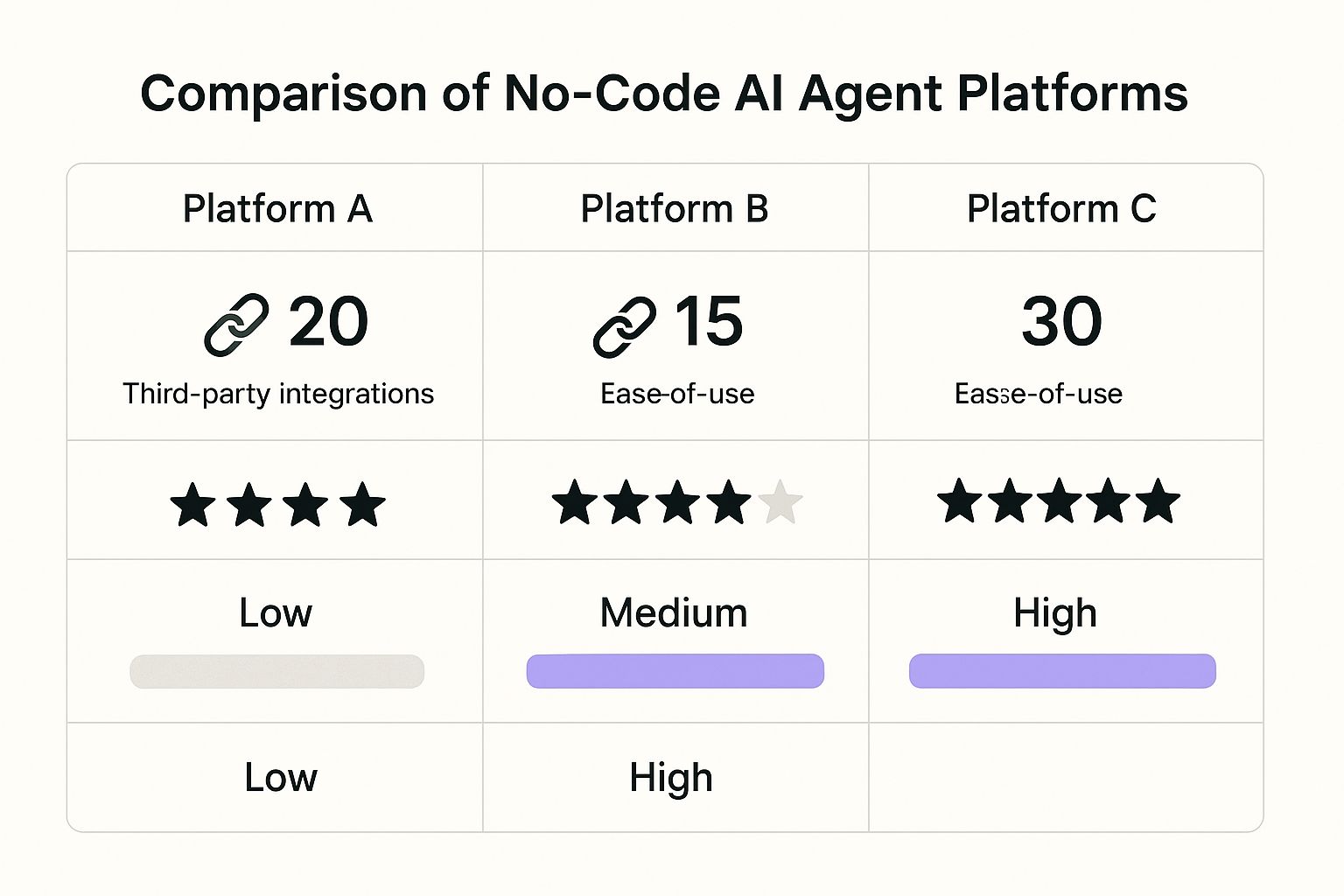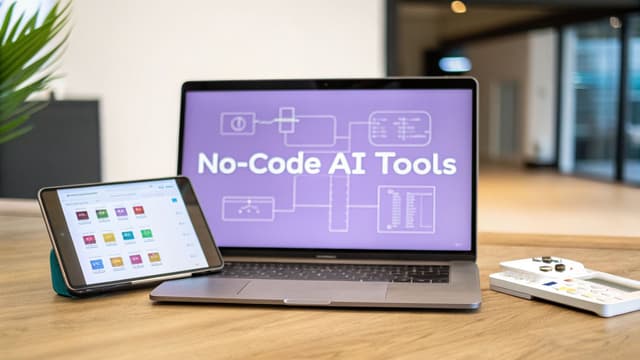Making Sense of No Code AI Agent Builders
Imagine having a team member who never sleeps, never takes a break, and can handle dozens of tasks at once. This isn't science fiction; it's the new reality made possible by no-code AI agent builders. If you’ve ever used a drag-and-drop website builder, you already understand the core idea. These platforms are doing the exact same thing for artificial intelligence, removing the need for complex coding.
This change puts powerful automation tools directly into the hands of the people who know the business problems best—entrepreneurs, marketers, and customer support managers. Instead of waiting on a dedicated team of developers, you can now build your own digital workforce (how to deploy an AI agent on your website). The first step to understanding a no code AI agent builder is to picture what these agents can do, much like a tireless 24/7 AI employee. This access allows you to create solutions for your specific challenges without writing a single line of code.
From Abstract Concept to Practical Tool
At its core, a no-code AI agent builder is a platform with a visual interface—think flowcharts and drag-and-drop menus—used to create autonomous software agents. These agents can perform tasks, make decisions, and connect with other software based on instructions you provide in plain English. The platform handles all the complicated coding in the background, turning your business logic into a functional AI.
This shift from intricate programming to simple design is a major step forward. The screenshot below from Wikipedia’s page on Artificial Intelligence shows the broad and often academic scope of the field, which can feel unapproachable.

No-code platforms take these complex ideas and package them into practical, usable components. This makes AI a real asset for daily business operations instead of just a theoretical subject.
Why This Matters for Your Business
The biggest benefit is empowerment. You no longer need to send a request to an IT department and wait weeks for a simple automation. Instead, you can directly build an agent to manage customer questions, qualify sales leads, or process new orders. This ability to act immediately speeds up innovation and problem-solving within your company. For a closer look at the platforms driving this change, check out our guide on no-code AI tools.
Growing confidence in these tools is clear from wider industry trends. The rise of no-code AI builders reflects an increasing belief in AI's business value. Recent data shows that 87% of global organizations believe AI gives them a competitive edge, a significant jump from previous years. This statistic points to a clear market direction: businesses are actively looking for accessible AI solutions to get ahead. You can explore the full AI statistics report to learn more. This movement is not just about technology; it's about fundamentally altering how we work, solve problems, and grow businesses.
The Explosive Growth Behind No Code AI Platforms
The buzz around no-code AI isn't just hype; it's a sign of a major market shift. Think back to the early, energetic days of cloud computing or social media—that same rapid adoption is happening right now with platforms that let anyone build AI. This growth isn't an accident. It’s powered by a perfect combination of business needs, new technology, and a significant skills gap that has left many companies struggling to keep up.
The demand for AI expertise has soared past the number of available engineers, creating a roadblock for progress. For years, building custom AI was a luxury only large corporations with big budgets could afford. A no-code AI agent builder directly solves this problem. It acts as a great equalizer, putting powerful automation into the hands of subject-matter experts—the marketing managers, customer service leads, and operations specialists who know their challenges best. This change lets them solve problems directly, without needing to explain their needs to a separate technical team.
Market Momentum and Economic Drivers
The financial world has definitely taken notice. Businesses are under constant pressure to work more efficiently and provide better customer experiences. Those that don't automate important processes risk falling behind their more nimble competitors. In this environment, using no-code AI is not just a benefit but a key strategy for survival and growth.
The numbers back this up. The market for these platforms is on a steep upward path. As you can see in the table below, the projections show a dramatic expansion, highlighting the huge demand for easy-to-use AI solutions across all industries.
To give you a clearer picture of this trend, here are the market projections for no-code AI platforms.
No-Code AI Market Growth Projections
| Year | Market Size (Billions) | Growth Rate | Key Drivers |
|---|---|---|---|
| 2024 | $4.9 | - | High demand for automation, AI talent shortage |
| 2025 | ~$6.8 | 38.2% CAGR | Increased adoption by Small and Medium Businesses (SMBs) |
| 2027 | ~$13.3 | 38.2% CAGR | Rapid prototyping needs, speed-to-market pressure |
| 2029 | ~$25.0 | 38.2% CAGR | AI becoming a standard business tool for competition |
The consistent and high Compound Annual Growth Rate (CAGR) of 38.2% shows that this isn't a short-term trend. It's a sustained shift in how businesses are choosing to operate, moving from complex, coded solutions to accessible, user-friendly platforms. You can learn more about these figures and the factors behind them in the full research on no-code AI platforms.
Why This Growth Is More Than Just a Number
This expansion is more than just a figure on a chart; it represents a fundamental change in how businesses function. It marks the "democratization of AI," moving powerful technology from exclusive labs into everyday business operations. Key forces making this growth sustainable include:
- AI Talent Shortage: No-code platforms reduce the need for expensive, hard-to-find developers. This allows small and medium-sized businesses to compete with larger companies.
- Speed to Market: Teams can quickly build and launch AI solutions in days, not months. This helps businesses adapt quickly to changing customer needs.
- Cost Efficiency: It significantly lowers the financial barrier to using advanced automation, making powerful AI available to companies with smaller budgets.
- Increased Competition: Automation is no longer just an IT project but a core part of business strategy, pushing companies to adopt these tools to stay competitive.
Ultimately, the rise of the no-code AI agent builder is a direct response to real-world business needs. It offers a practical, efficient, and scalable way for companies of all sizes to use artificial intelligence, turning a once-inaccessible technology into a vital tool for daily problem-solving.
Essential Features That Separate Great Platforms From Good Ones
Not all platforms labeled as a no-code AI agent builder are created equal. While many can handle simple automations, the truly powerful ones provide a rich set of features that turn complex ideas into functional, intelligent agents without demanding a technical background. These core capabilities are what separate a basic tool from a platform that can genuinely support and scale a business. At the forefront is the user experience itself—it must be more than just functional; it needs to be intuitive.
A great platform feels less like a complicated piece of software and more like a logical extension of your own thinking. The best ones achieve this through visual, drag-and-drop workflow builders. These interfaces allow you to map out business processes—like qualifying a lead or answering a support ticket—step-by-step, just as you would on a whiteboard. This visual approach demystifies AI, making it accessible to anyone on your team.
This clarity allows business experts, not just developers, to design and refine agent behavior, ensuring the final product perfectly matches operational needs.
Core Capabilities to Look For
Beyond a great interface, several other features are critical. The ability to connect with the tools you already use is paramount. A platform’s value multiplies when its agents can communicate with your CRM, ticketing system, or e-commerce platform. This is where pre-built integrations and a robust API become essential, allowing your AI agent to pull order data from Shopify or update customer records in Salesforce automatically.
Another key feature is sophisticated natural language processing (NLP). Popular underlying models include GPT-4, Claude, and Grok 3.. It’s not enough for an agent to just recognize keywords; it must understand intent, context, and sentiment. This allows for more human-like conversations and accurate problem-solving. Look for platforms that support multiple languages and can learn from interactions to improve their responses over time.

As the infographic illustrates, there is often a trade-off between the number of integrations, ease of use, and customization. This makes it important to choose a platform that aligns with your specific technical comfort and business goals.
Distinguishing Between Essential and Advanced Features
To help you evaluate different platforms, it’s useful to distinguish between the foundational features every tool should have and the advanced capabilities that give you a competitive edge. The table below breaks down these features to provide a clearer picture of what to look for.
| Feature Category | Essential Features | Advanced Features | Business Impact |
|---|---|---|---|
| Workflow Creation | Simple drag-and-drop interface for linear tasks. | Conditional logic (if/then statements) and complex branching paths. | Advanced logic allows agents to handle nuanced customer journeys and exceptions without human intervention. |
| Integrations | Pre-built connectors for major tools (CRM, email, e-commerce). | Custom API access, webhook support, and direct database connections. | Enables deep integration with proprietary or less common software, creating a truly unified tech stack. |
| AI Capabilities | Basic NLP for keyword recognition and simple Q&A. | Sentiment analysis, adaptive learning, and intent recognition. | Moves from a simple bot to an intelligent assistant that understands customer emotion and improves over time. |
| Analytics & Reporting | Basic conversation logs and simple usage metrics. | Interactive performance dashboards, A/B testing for responses, and user journey funnels. | Provides actionable insights to optimize agent performance, improve conversion rates, and enhance user experience. |
This table shows that while essential features get you started, advanced features are what unlock significant operational efficiency and a more sophisticated customer experience. A platform with a solid foundation and a clear path to advanced capabilities is ideal for long-term growth.
Real Success Stories Across Industries
The true value of any technology is proven when you see it solving real problems for actual businesses. A no-code AI agent builder is no different. It's one thing to talk about features and potential, but it’s another to see these tools actively improving how a company operates. These success stories show how creative problem-solving can turn a good platform into a great business solution.

E-commerce Customer Service Automation
Imagine a small e-commerce store buried under a constant stream of repetitive customer questions. Inquiries about order status, return policies, and product details were eating up hours of their team’s day. By setting up a no-code AI agent on their website and WhatsApp, they automated responses to over 70% of these common questions.
The agent connected directly with their order management system, giving customers instant, correct updates any time of day. This change allowed the human team to focus on complex, high-value customer issues, improving both efficiency and satisfaction.
Marketing and Lead Qualification
A digital marketing agency had a different bottleneck: sorting through hundreds of new leads to find the few who were truly ready to buy. Their sales team was wasting valuable time on prospects who weren't a good match. They built a lead qualification chatbot for their website using an AI agent builder.
This agent engaged website visitors, asked specific questions about their budget and needs, and even booked discovery calls for promising leads right into the sales team's calendar.
This simple automation produced clear results:
- The sales team’s time was now spent only on pre-qualified leads.
- The agency reported a 35% increase in qualified leads sent to the sales team.
- Conversion rates from first contact to a paying client nearly doubled.
For businesses that want to achieve similar results, learning how to use a chatbot for lead generation is the perfect starting point.
Improving Internal Operations
The benefits aren't just for customer-facing tasks. An HR department completely changed its hiring process with a custom AI agent. The agent screened initial applications, sent preliminary questions to candidates via email, and scheduled interviews for those who met the key criteria. This straightforward workflow cut the time-to-hire by almost 40%, letting recruiters focus on building relationships with top talent.
These examples are just a small part of a much bigger shift. The AI agent market, valued at around $5.4 billion in 2024, is projected to grow to over $47 billion by 2030. This incredible growth shows the real, measurable value these agents are providing across many industries. You can discover more about these AI agent statistics and the trends fueling this expansion.
Why Smart Businesses Are Making The Switch
The move toward no-code AI agent builders is about much more than just saving money on developers. It’s a fundamental change in how companies innovate and stay competitive. Think of it like the difference between renting specialized equipment for a single project versus owning a fully equipped workshop. While both get the job done, owning the workshop gives you the freedom to experiment, iterate, and build precisely what you need, exactly when you need it. This freedom is the core reason smart businesses are adopting these platforms.
The biggest benefit is the democratization of AI development. For years, creating intelligent automation was a difficult, drawn-out process. It created a bottleneck where business experts had to translate their needs to small, expensive technical teams. No-code platforms smash this barrier. They put the power to create directly into the hands of the people who understand the business problems best—the customer service managers, marketing leads, and operations specialists. This direct control means the final AI agents are perfectly matched to real-world operational needs.
Speed and Agility in a Competitive Market
Another key driver is the incredible speed these platforms provide. Traditional software development can take months, or even years, to go from an idea to a working solution. With a no-code AI agent builder, a functional prototype can be built and tested in a matter of days or weeks. This rapid cycle lets businesses test new ideas, react to market shifts, and fine-tune their processes with an agility that was once out of reach.
This speed creates a powerful competitive edge. For instance, a business can quickly deploy an agent to manage a surge in customer questions after a new product launch, gathering useful feedback and improving the customer experience on the fly. You can explore a variety of business process automation examples to see what’s possible.
Strategic and Financial Advantages
The strategic gains from building in-house AI capabilities are significant. When companies empower their teams to create their own solutions, they grow a culture of innovation and problem-solving. This not only makes operations more efficient but also builds a more resilient and adaptable organization. To better understand the strategic importance of this technology, you can learn about the integral role of AI in a modern tech stack.
Of course, the financial benefits are also clear. By cutting down on the need for specialized developers and speeding up project timelines, these platforms make advanced AI accessible to organizations of all sizes. Key benefits include:
- Reduced Development Costs: Sidesteps the need for large, specialized development teams.
- Faster Time-to-Value: Solutions are deployed more quickly, generating returns on investment sooner.
- Enhanced Scalability: AI agents can be scaled up to handle more demand without a matching increase in costs.
Finding Your Perfect No-Code AI Platform Match
Choosing the right no-code AI platform feels a lot like picking a vehicle for a cross-country road trip. A flashy sports car looks great, but it’s a poor choice for a family of five planning to explore mountain roads. In the same way, the “best” no-code AI agent builder isn’t the one with the longest feature list, but the one that aligns with your specific business goals, team abilities, and budget. An honest look at your own needs is the first step to making a smart choice that will pay dividends.
Before you start comparing platforms, you need to know where you're going. Clearly define what a successful outcome looks like for your business. Are you trying to reduce customer support tickets, qualify more sales leads, or automate internal HR tasks? Your main objective will instantly narrow the options. A platform designed for e-commerce support will have different strengths than one built for automating complex internal workflows.
Key Evaluation Criteria for Your Shortlist
Once your destination is clear, you can start looking at the vehicles. Concentrate on the factors that will directly contribute to your success, and don't get sidetracked by impressive features you'll never actually use. Instead, focus on these practical points:
- User Interface (UI) and Learning Curve: Is the platform straightforward for your team? A clean, visual builder like the one offered by FlowGent AI lets non-technical users map out complex workflows without feeling lost. If your team is made up of marketers or support agents, a friendly drag-and-drop interface is essential.
- Integration Capabilities: Your AI agent needs to talk to the tools you already use. Look for ready-made connections to your CRM, e-commerce software, and helpdesk systems. A platform with a robust integration library ensures your powerful new tool doesn't end up isolated from the rest of your business operations.
- Scalability and Pricing: Think about your future needs. A platform might seem cheap today, but will the cost still make sense as your usage increases? Seek out transparent, usage-based plans that can grow with your business without causing shocking price hikes.
- Customer Support and Documentation: What happens when you hit a snag? Look for platforms with thorough documentation, active user communities, and helpful customer service. Quality support can be the difference between a minor hiccup and a project-halting disaster.
Making the Right Choice with Confidence
A great way to gauge a platform's ease of use is to look at its core workflow builder. For example, the FlowGent AI screenshot below shows a clear, step-by-step visual editor for designing an agent's logic.

This type of interface makes it simple to understand and adjust an agent's behavior, which is vital for teams that don't have a dedicated developer. By breaking the process into easy-to-manage blocks, it gives users the confidence to build sophisticated automation.
To make your final call, try creating a simple evaluation chart. List your essential features down one side and your top platform candidates across the top. Score each platform on how well it meets your criteria. This structured method takes the emotion out of the decision and helps you clearly identify which option offers the best value for your unique situation. Selecting the right no-code AI agent builder is an investment in your company’s future efficiency, so taking the time to choose carefully is crucial.
Your First Steps Into No Code AI Success
Diving into a no-code AI agent builder should feel like an exciting new beginning, not a massive headache. Picture it like learning to drive a car; you don't start by entering a race. You begin in an empty parking lot, getting a feel for the basics and building your confidence before you even think about merging onto the highway. This exact mindset—starting small and celebrating early wins—is how you'll master AI agents and avoid the common stumbles many beginners face.
Your first steps aren't about building a massive, all-knowing AI right away. It's about laying a solid foundation for everything that comes next. This means getting your workspace organized, understanding the basic building blocks of the platform, and choosing a first project with a single, clear goal.
Planning Your First Project
The most common mistake people make is trying to build their magnum opus on day one. An agent that can do everything is an agent that's hard to get right. Instead, pick one simple, high-value problem you can solve quickly. A perfect first project might be an agent that answers one specific, common question, like "What are your business hours?" or "Can you explain your return policy?"
This focused approach gives you several key benefits:
- Low Risk: A simple agent is much easier to test and troubleshoot, which keeps frustration low and morale high.
- Fast Wins: You can launch a working agent in a short amount of time, proving its value to your team almost immediately.
- Focused Learning: It forces you to master the core platform features, like triggers and responses, without getting lost in more complex options.
Building and Testing Your Agent
With a clear plan in hand, building your agent should feel like putting together LEGOs. You'll use the platform’s visual builder to connect a trigger (like a customer asking a question) to an action (like the agent delivering a prepared answer). Research on no-code tools from sources like Budibase shows that these drag-and-drop interfaces are specifically made to help people without a technical background turn their ideas into working systems.
Before you set your agent loose, thorough testing is non-negotiable. Go through different scenarios to see how it performs. Try asking the same question in a few different ways to check if it understands natural language. This cycle of building, testing, and tweaking is where the real learning happens. As you get more comfortable, you can begin exploring advanced features and taking on bigger challenges.
Ready to take your first step with confidence? FlowGent AI offers an intuitive, no-code platform designed to make building your first AI agent a simple and successful experience. Start automating your business today.

